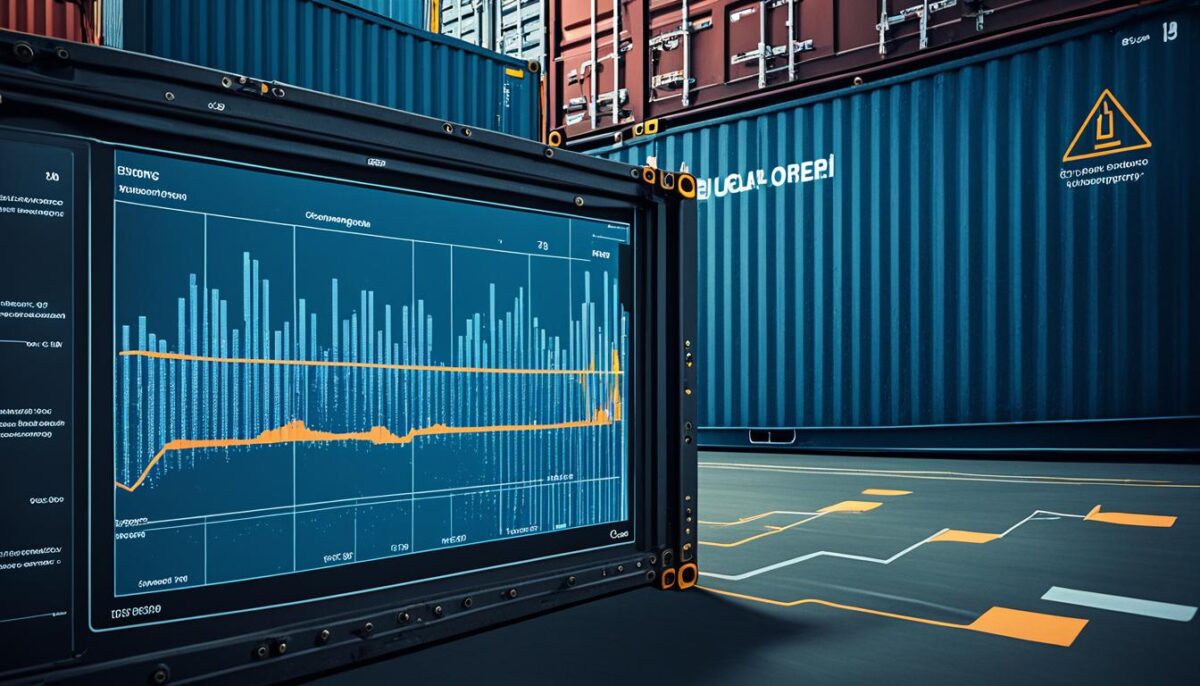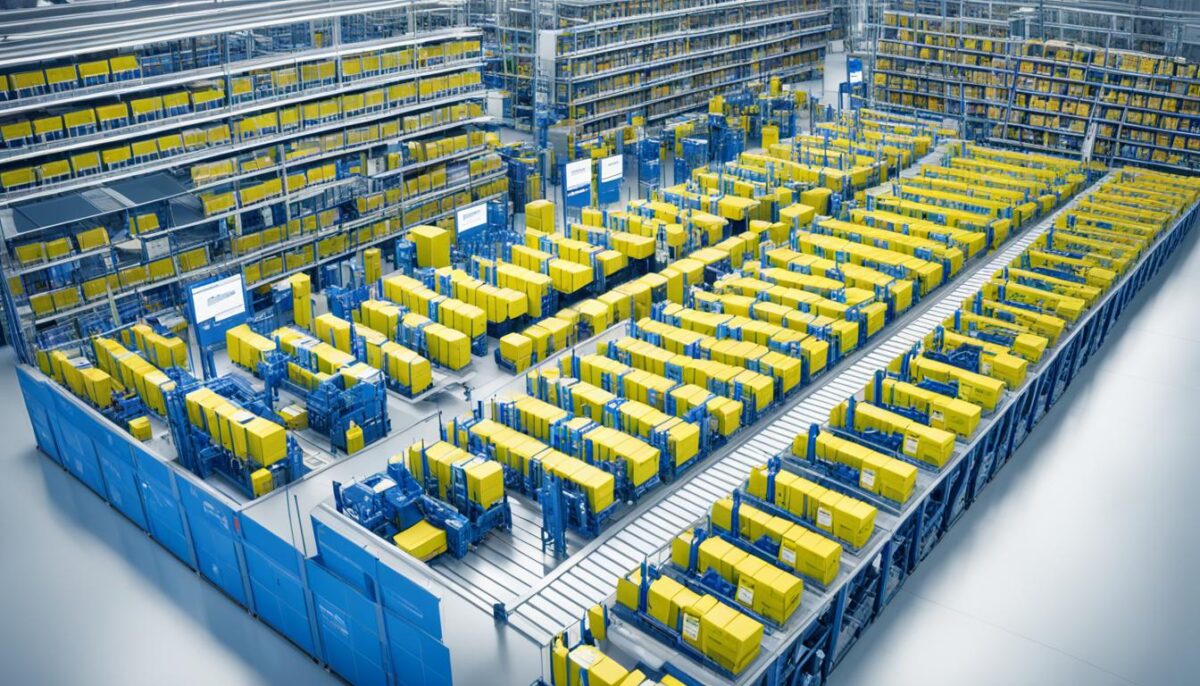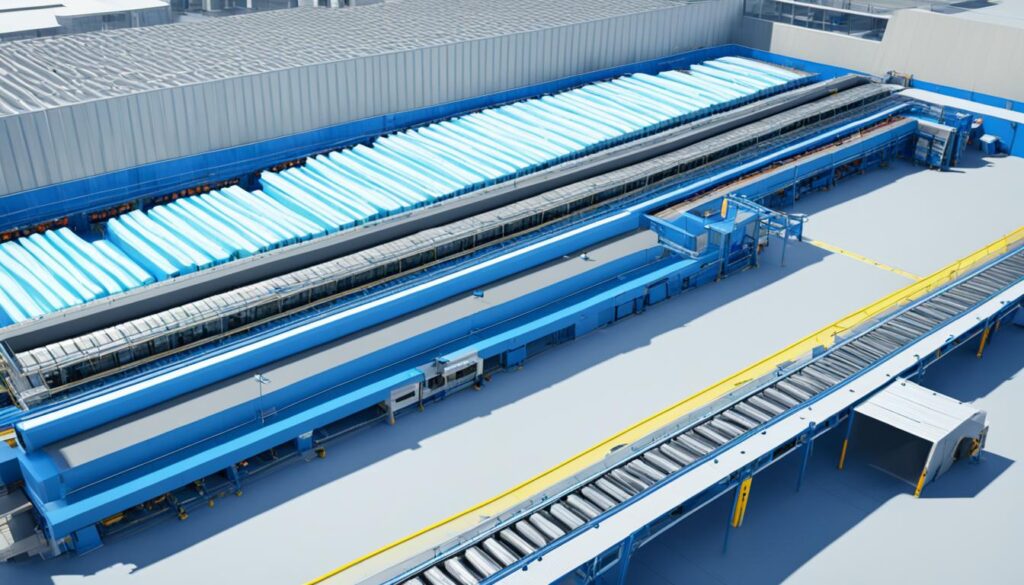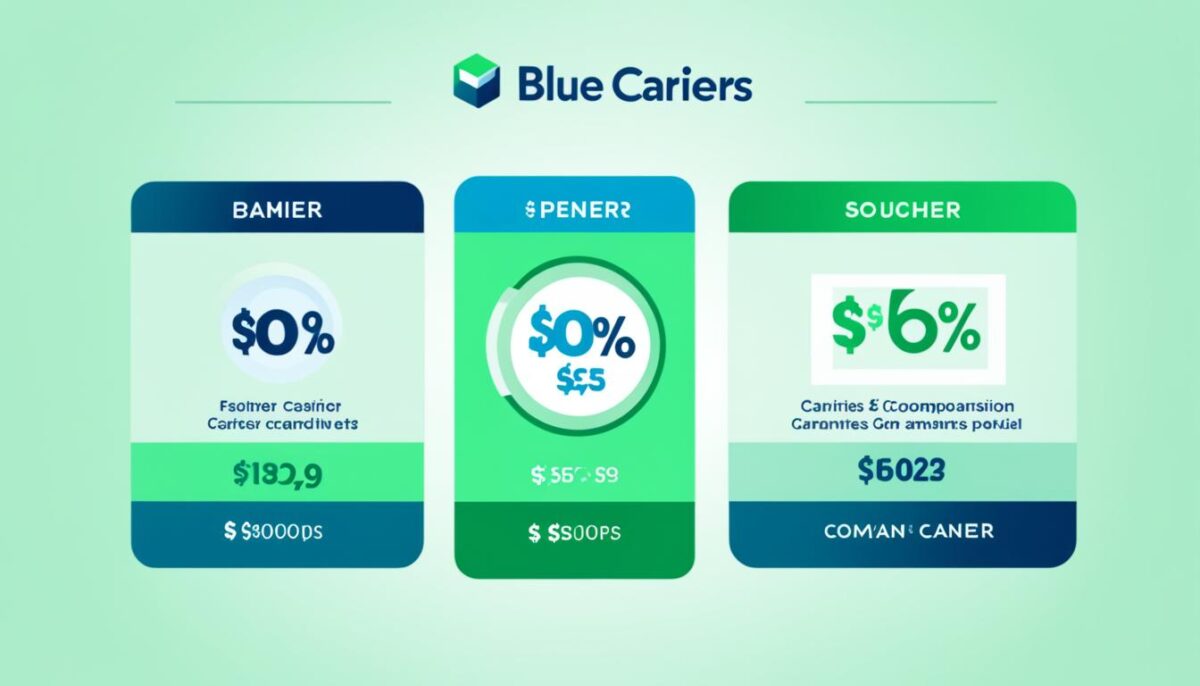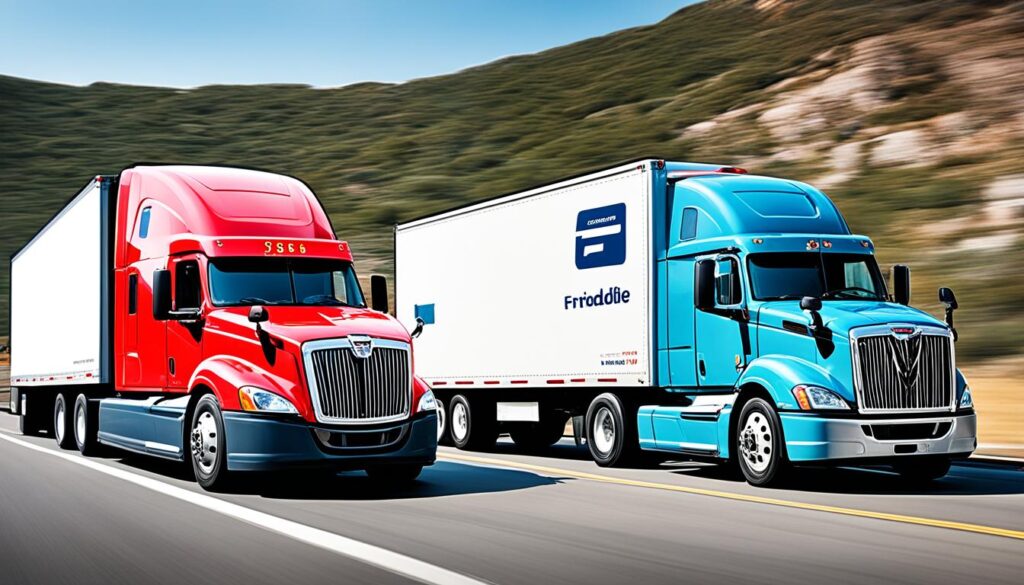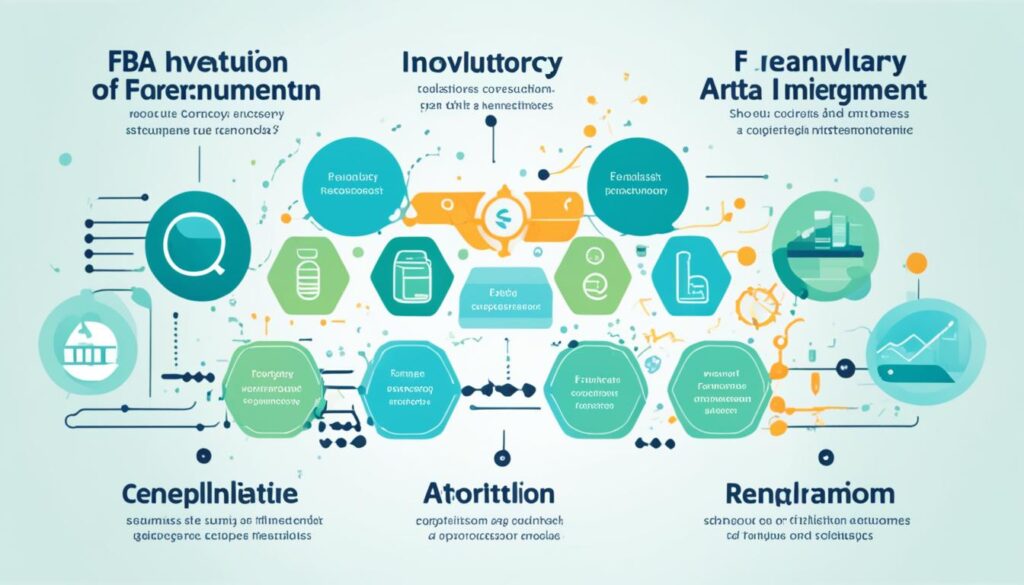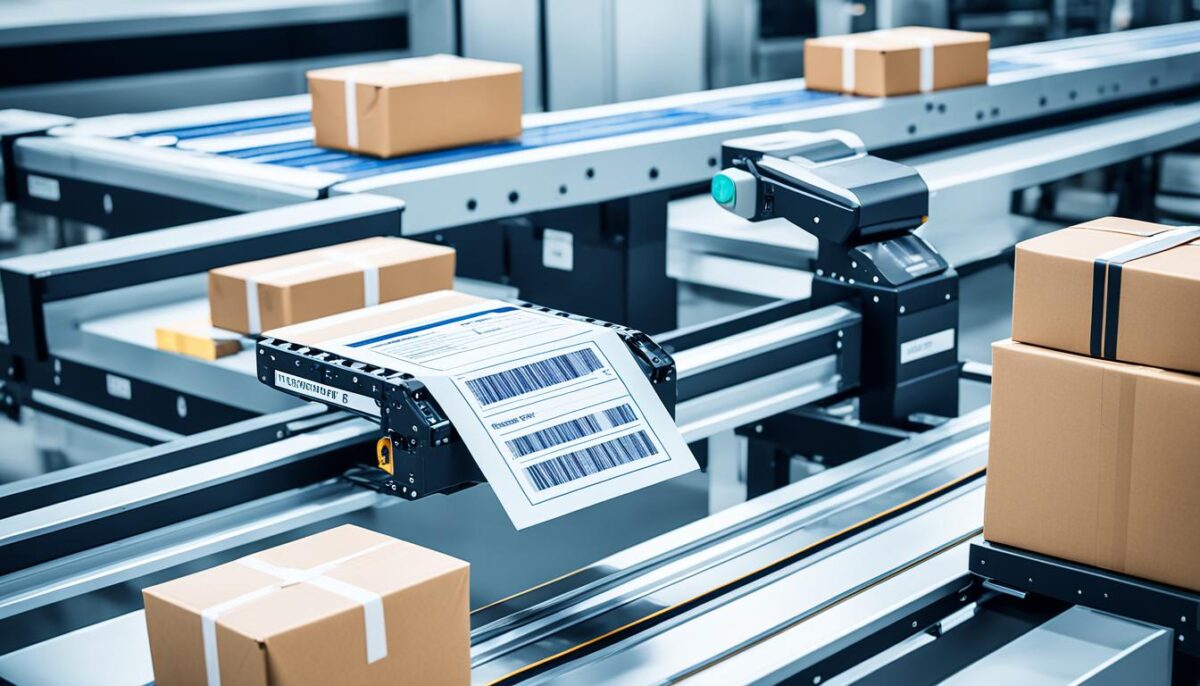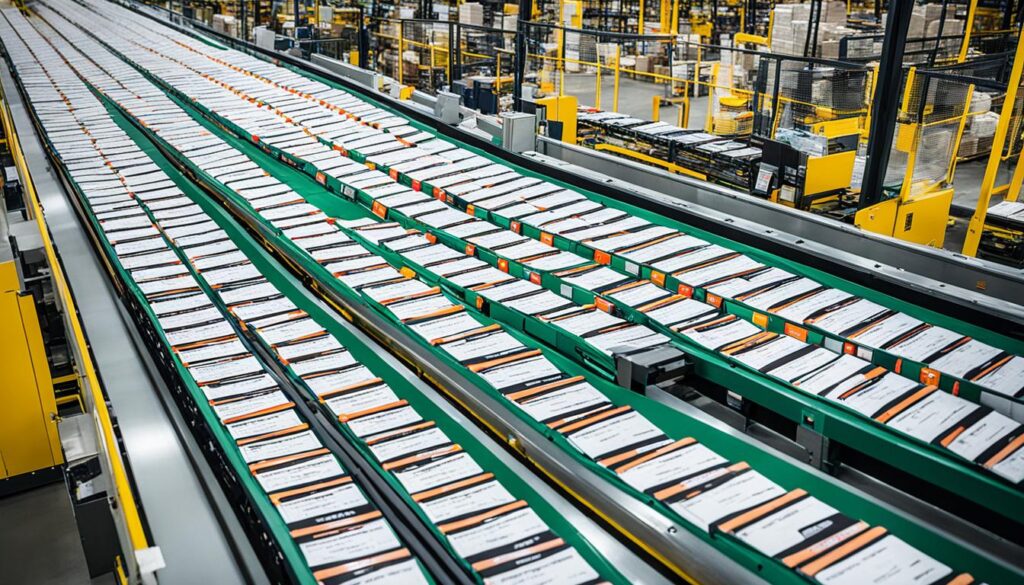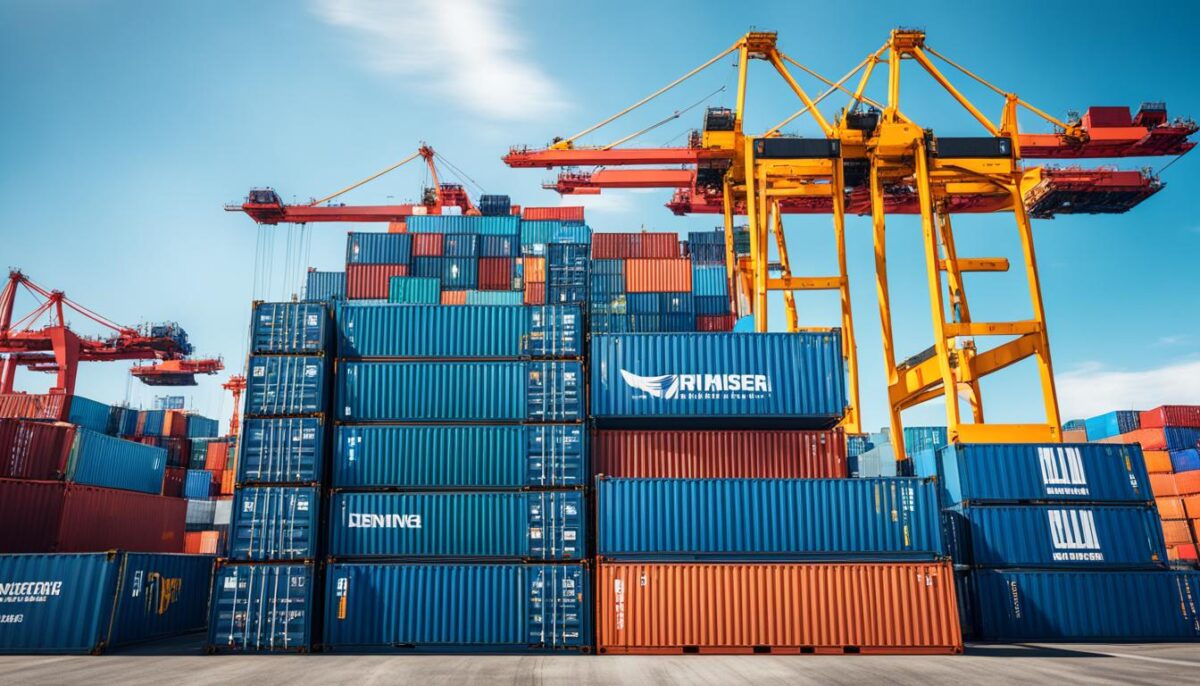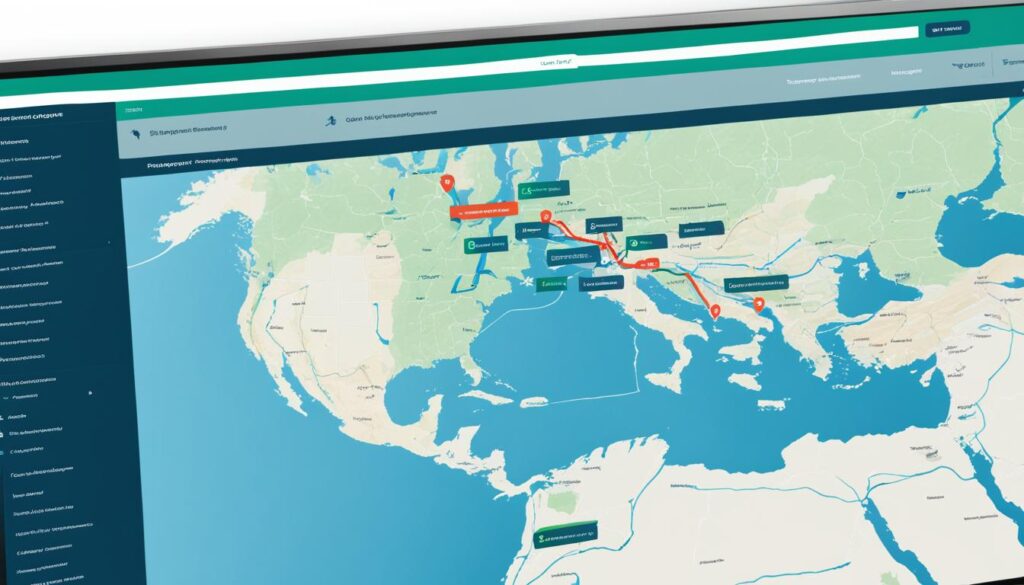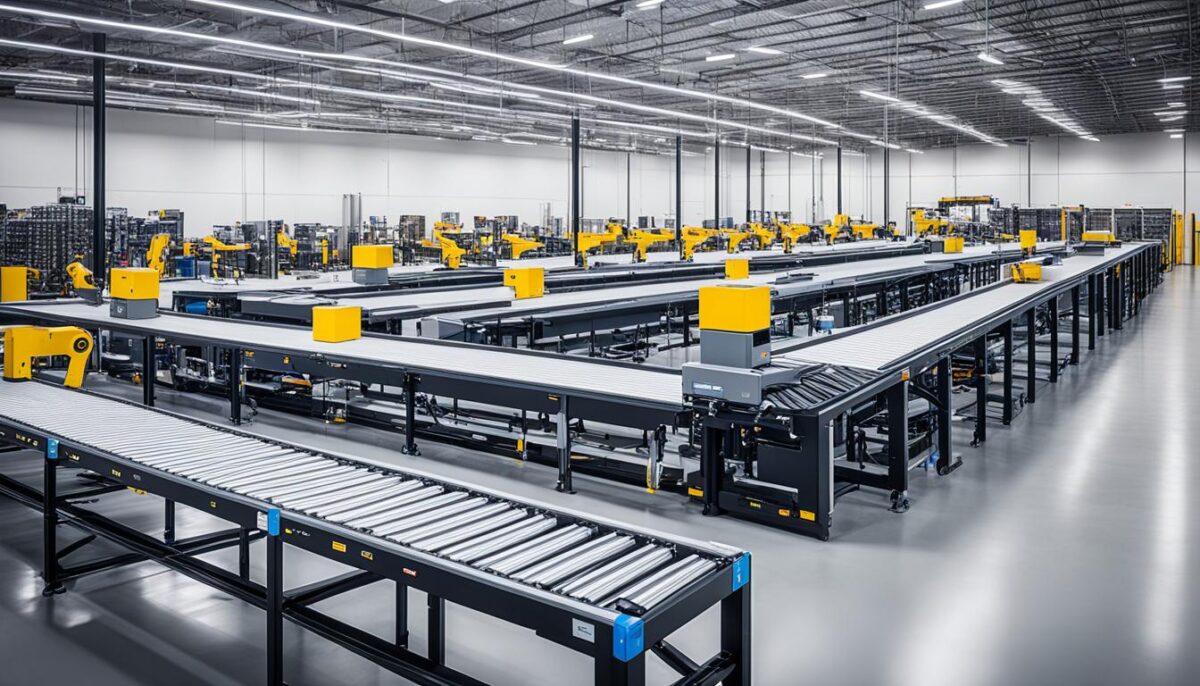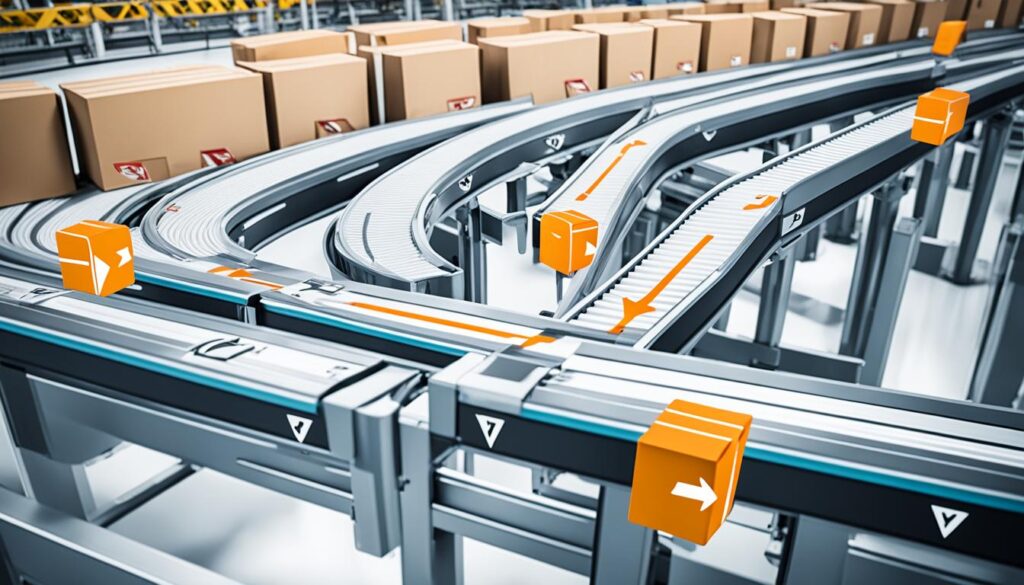Optimize Shipping with Logistics Software
Efficient and cost-effective shipping is essential for any business, regardless of its size. With the complex processes involved in shipping and logistics, it can be challenging to keep track of everything while maintaining smooth operations. This is where shipping and logistics software comes in, helping businesses automate tasks, streamline processes, and optimize their entire supply chain.
Shipping and logistics software refers to a suite of solutions that help businesses manage their shipping and logistics operations more efficiently. By using integrated software, businesses can improve inventory management, track shipments in real-time, and manage transportation more effectively, reducing operational costs and boosting profitability in the process.
Key Takeaways:
- Shipping and logistics software is essential for improving shipping processes, especially for businesses of all sizes.
- Logistics software helps automate tasks, streamline processes, and optimizes the entire supply chain, which can reduce operational costs and boost profitability.
- Shipping and logistics software solutions provide a range of functionalities, including inventory management, real-time shipment tracking, and transportation management.
- Considering key features such as scalability, integration capabilities, user-friendliness, and customer support can help businesses choose the right software solution.
- The implementation and optimization process is critical for successful integration, resulting in maximum benefits from the chosen software solution.
Streamline Your Supply Chain with Shipping and Logistics Software
Logistics management software and shipping software solutions have become integral tools for businesses looking to streamline their supply chain operations. These software systems offer a range of features and benefits that can help companies manage inventory, track shipments, and improve communication between stakeholders.
One of the key advantages of logistics management software is its ability to centralize information and automate processes, which can help reduce errors and save time. With features like real-time inventory tracking, businesses can get a clearer view of their stock levels and make informed decisions about when to reorder and how much to order.
Shipping software solutions, on the other hand, offer features like transportation management and carrier selection tools that can help businesses optimize routes and reduce freight costs. Additionally, these solutions often include tools for customer relationship management and communication, allowing businesses to keep their customers informed and satisfied throughout the shipping process.
By combining logistics management software with shipping software solutions, businesses can achieve end-to-end visibility of their supply chain and make data-driven decisions that lead to greater operational efficiency and cost savings. This can be particularly beneficial for businesses that are experiencing rapid growth or dealing with complex supply chain networks.
Furthermore, implementing logistics software systems and shipping software solutions can help businesses stay competitive in today’s fast-paced shipping industry. With the ability to offer faster shipping times, better tracking, and more efficient processes, businesses can better meet customer expectations and build a reputation for excellence.
In the next section, we will explore the benefits of transportation management software in optimizing shipping operations.
Enhance Transportation Management with Software Solutions
Running a successful shipping operation requires effective transportation management. This is where transportation management software comes into play. With the right software solution, businesses can easily manage shipments, optimize delivery routes, and reduce transportation costs. One such software solution is freight management software, which helps businesses streamline the entire shipping process.
| Key features of freight management software: |
|---|
| Shipment tracking: Provides real-time tracking of shipments from pick-up to delivery. |
| Route optimization: Determines the most efficient route for deliveries, taking into account factors such as traffic conditions and delivery priorities. |
| Automated billing: Generates accurate invoices based on shipment data and carrier rates. |
In addition to freight management software, there are other transportation management software solutions that can help businesses improve their shipping operations. These solutions offer functionalities such as load optimization, carrier selection, and mode optimization. With transportation management software, businesses can gain complete visibility into their supply chain, which can help them make informed decisions and improve overall efficiency.
By leveraging transportation management software, businesses can gain a competitive edge in the shipping industry. They can reduce transportation costs, increase efficiency, and improve their customers’ experience. If you’re looking to enhance your transportation management, consider investing in the right software solution for your business.
Improve Supply Chain Efficiency with Software Systems
In today’s business landscape, supply chain management software and shipping logistics software have become essential tools for improving operational efficiency. These software systems offer a variety of features that can help streamline supply chain processes to ensure smooth and efficient operations.
One of the primary benefits of supply chain management software is automation. This software can automate various tasks such as data entry, order processing, and inventory management. By automating these tasks, businesses can reduce human error and increase efficiency, ultimately saving time and money.
Shipping logistics software is also an important tool for businesses looking to optimize shipping processes. This type of software can help optimize inventory levels, track shipments, and facilitate communication between stakeholders. By doing so, businesses can improve their logistics management, reduce shipping costs, and enhance customer satisfaction.
Furthermore, shipping logistics software can help synchronize processes between different departments within a company. For example, if the sales team has information on a specific customer order, the shipping team can use this information to plan and optimize delivery routes. This synchronization helps streamline communication and ensure that everyone involved in the supply chain is working towards the same goal.
Overall, supply chain management software and shipping logistics software are critical tools for businesses looking to improve their operational efficiency. By automating tasks, optimizing shipping processes, and synchronizing operations, these software systems can help companies reduce costs, save time, and ultimately increase profitability.
Streamline Warehouse Operations with Management Software
Warehouse management software can be a game-changer for businesses that rely on warehouse operations to store and ship products. By implementing this software, businesses can optimize their warehouse processes, reduce operational costs, and improve overall efficiency.
One of the key benefits of warehouse management software is improved inventory control. With this software, businesses can track warehouse stock levels in real-time and optimize inventory placement for faster and more accurate order fulfillment. Additionally, warehouse software can help streamline shipping processes by providing tools for tracking shipments within the warehouse and managing logistics.
Using warehouse management software can also help enhance overall warehouse efficiency by automating manual tasks and optimizing workflows. This can help minimize errors and improve productivity, ultimately leading to a more streamlined and cost-effective warehouse operation.
Overall, implementing warehouse management software should be a top priority for businesses looking to optimize their supply chain operations and gain a competitive edge in the shipping industry.
Boost Visibility and Tracking with Advanced Software Solutions
In today’s fast-paced business environment, real-time visibility and tracking capabilities are crucial for effective supply chain management. This is where advanced logistics software systems come into play. By leveraging the power of these solutions, businesses can monitor shipments, track inventory levels, and gain valuable insights into their supply chain performance. The enhanced visibility and tracking offered by logistics software systems can help reduce lead times, minimize inventory carrying costs, and improve customer satisfaction rates.

Using logistics software systems also helps businesses to minimize the risks of lost or damaged goods. By tracking their shipments in real-time, they can take proactive measures to mitigate any issues that may arise during transit. Additionally, logistics software systems make it easy for businesses to comply with regulatory requirements related to shipping and transportation, ensuring they avoid costly penalties and delays.
“The enhanced visibility and tracking offered by logistics software systems can help reduce lead times, minimize inventory carrying costs, and improve customer satisfaction rates.”
Some of the key features to look for in advanced logistics software systems include:
| Feature | Description |
|---|---|
| Real-time tracking | Provides businesses with real-time visibility into shipment status and location |
| Automatic alerts | Automatically sends alerts to businesses for critical updates on shipments and inventory |
| Optimization tools | Enables businesses to optimize routes, carrier selection, and transportation modes to reduce costs and improve efficiency |
| Data analytics | Provides businesses with valuable insights into supply chain performance to identify areas for improvement and cost savings |
While there are many different logistics software systems available on the market, it’s important for businesses to choose the one that best fits their unique needs. Look for software that offers scalability, integration capabilities, user-friendliness, and reliable customer support. By selecting the right software solution, businesses can maximize the benefits of real-time visibility and tracking and gain a competitive edge in the shipping industry.
Maximize Profitability with Integrated Software Solutions
Businesses can achieve optimal profitability by integrating supply chain management software with freight management software. This integration streamlines data sharing, increases visibility, and facilitates efficient decision-making.
The supply chain management software enables businesses to automate tasks, optimize inventory levels, and synchronize processes to ensure smooth supply chain operations. The freight management software helps businesses effectively manage shipments, track delivery routes, and optimize transportation costs. By combining these solutions, businesses can maximize profitability by reducing operational costs and increasing overall efficiency.
Integrated software solutions enable businesses to:
- Automate data sharing processes for better communication and collaboration
- Track inventory levels across multiple locations and optimize shipment routes
- Monitor transportation costs and reduce expenses
- Gain real-time visibility into the supply chain, enabling quick decision-making
Real-Life Example:
Zoomer implemented an integrated software solution, combining their supply chain management software with freight management software. The results were impressive, with a 20% reduction in operational costs and a 30% increase in overall efficiency. The software system enabled the company to track inventory levels across multiple locations, optimize shipment routes, and reduce transportation costs significantly.
Integrating these software solutions is the ideal way to maximize profitability and ensure smooth supply chain operations. Contact us today to learn more about how supply chain management software and freight management software can benefit your business.
Key Features to Look for in Logistics Software
When searching for logistics software, it’s essential to consider a range of features to ensure you get the best solution for your business needs. Here are some key features to look for:
- Order Management: A robust order management system is crucial for efficient supply chain operations. Look for software that provides real-time order tracking, automatic order processing, and detailed order history reports.
- Route Optimization: Shipping and logistics software should offer advanced routing capabilities that optimize delivery routes based on parameters such as delivery windows, traffic, and fuel costs, reducing transportation times and lowering costs.
- Inventory Tracking: A powerful inventory management system should be designed to track inventory levels in real-time to avoid stockouts, prevent overstocking and reduce carrying costs.
- Reporting Capabilities: Reporting tools that provide granular visibility into supply chain activities can help businesses identify inefficiencies, monitor KPIs, and optimize their logistics performance. Make sure the software solution has a customizable reporting dashboard that delivers critical insights at a glance.
- Compatibility: Logistics software that integrates smoothly with other systems and software can streamline operations and improve efficiency. Look for a software solution that offers compatibility with existing systems, such as ERP and CRM software.
By selecting software with these capabilities, your business can improve supply chain efficiency, lower shipping costs, and provide better customer service. With comprehensive logistics management software, you can streamline your shipping processes and gain a competitive edge in the industry.
Choosing the Right Software Solution for Your Business
When selecting a software solution, businesses must consider several factors to ensure they choose a solution that aligns with their specific needs.
Scalability
Businesses should opt for a shipping software solution that can scale as their business grows. This will allow them to add functionalities as they need them and ensure the software solution can handle their future needs.
Integration Capabilities
Logistics software systems must be able to seamlessly integrate with other systems already in place. This will help minimize disruptions and ensure effective data exchange across the supply chain.
User-Friendliness
Businesses must select an easy-to-navigate and user-friendly software solution. Sufficient training resources must be available to employees to ensure the software’s maximum utilization and efficiency.
The right logistics software system must be user-friendly and provide a seamless experience for all supply chain stakeholders.
Customer Support
When selecting a logistics management software solution, businesses must ensure that customer support is available and responsive to any issues that may arise. This will help minimize downtime and ensure smooth operations in the supply chain.
By considering these factors, businesses can select the right shipping software solution for their specific needs, ensuring efficient and cost-effective supply chain management.
Implementing and Optimizing Logistics Software
Effective implementation and optimization of shipping and logistics software is essential for businesses to realize their full potential and gain a competitive edge in the industry. At the implementation stage, it is crucial to choose the right software solution that best meets the specific needs of the business. The chosen software solution should have a user-friendly interface, robust functionalities, and integration capabilities with other software tools in the business’s ecosystem.
After selecting the appropriate software solution, the business needs to focus on deploying and configuring the software solution to match the business’s unique requirements. This process involves setting user permissions, configuring workflows, automating tasks, and integrating with other software tools. It is crucial to work closely with the software vendor and ensure proper training for employees.
An important aspect that businesses must not overlook is ongoing maintenance and optimization. This process involves monitoring the performance of the software, identifying potential issues, and implementing updates and upgrades as necessary. Regular maintenance ensures that the software solution consistently operates at peak efficiency and maximizes the benefits it provides to businesses.
In conclusion, organizations that use shipping and logistics software, including logistics management software and supply chain management software, stand to gain significant benefits in optimizing their shipping processes. Implementing and optimizing these software solutions requires careful consideration, planning, and ongoing maintenance to ensure proper integration and maximize the benefits that the software provides.
Conclusion
Shipping and logistics software have become essential tools for businesses looking to optimize their supply chain operations. By utilizing logistics management software, shipping software solutions, transportation management software, warehouse management software, and other advanced logistics software systems, businesses can streamline their shipping processes, enhance inventory management, improve communication between stakeholders and gain real-time visibility into their supply chain performance.
When selecting the right shipping and logistics software solution, businesses should pay attention to key features like order management, route optimization, inventory tracking, and reporting capabilities. They should also consider factors like scalability, integration capabilities, user-friendliness, and customer support to choose the solution that best meets their specific needs.
Implementing and optimizing these software solutions is a crucial step towards gaining a competitive edge in the shipping industry. Businesses should follow best practices for successful integration, provide adequate training resources to employees, and ensure ongoing maintenance to maximize the benefits of their chosen software solution.
Overall, investing in shipping and logistics software is a smart choice for businesses looking to enhance their supply chain processes, reduce operational costs, and maximize profitability.
Learn More About Amazon FBA
FAQ
What is shipping and logistics software?
Shipping and logistics software refers to a technology solution designed to streamline and optimize shipping processes in the supply chain. It encompasses various functionalities like inventory management, order tracking, route optimization, and communication tools to improve operational efficiency and reduce costs.
How can logistics management software help businesses?
Logistics management software can help businesses by providing them with real-time visibility into their supply chain operations. It enables efficient inventory management, automates order processing, optimizes routes, facilitates communication with suppliers and customers, and generates valuable analytics for better decision-making.
What are the benefits of using shipping software solutions?
Shipping software solutions offer several benefits, including improved inventory control, enhanced order accuracy, reduced shipping errors, faster order processing and fulfillment, increased customer satisfaction, and significant cost savings through optimized shipping routes and transportation management.
How does transportation management software optimize shipping operations?
Transportation management software optimizes shipping operations by providing routing and scheduling tools to leverage the most efficient modes of transportation. It helps manage carrier contracts, track shipments in real-time, mitigate risks, improve delivery accuracy, and reduce transportation costs through intelligent load consolidation and optimization.
What is the role of freight management software?
Freight management software plays a crucial role in managing and optimizing freight transportation. It helps businesses streamline carrier selection, track and trace shipments, manage freight invoices and payments, analyze carrier performance, and leverage data for continuous process improvement and cost reduction.
How can supply chain management software enhance operational efficiency?
Supply chain management software improves operational efficiency by automating and integrating various supply chain processes, including procurement, inventory management, demand forecasting, order fulfillment, and logistics. It enables better resource allocation, streamlined workflows, reduced manual errors, and improved overall coordination between suppliers, manufacturers, distributors, and customers.
What is shipping logistics software?
Shipping logistics software is a comprehensive solution that combines shipping management and logistics functionalities. It helps businesses coordinate shipping operations, optimize routes, track shipments, manage inventory, and synchronize logistics activities to ensure smooth and efficient supply chain operations.
How does warehouse management software streamline warehouse operations?
Warehouse management software streamlines warehouse operations by automating processes like inventory tracking, order fulfillment, receiving, put-away, picking, packing, and shipping. It optimizes space utilization, improves inventory accuracy, reduces manual errors, provides real-time visibility into warehouse activities, and enhances overall operational efficiency.
Why is logistics software systems important for visibility and tracking?
Logistics software systems provide real-time visibility and tracking capabilities, allowing businesses to monitor and track shipments, inventory levels, and logistics activities throughout the supply chain. This visibility enables better decision-making, improved customer service, proactive issue resolution, and enhanced supply chain performance.
What are the benefits of integrating supply chain management software and freight management software?
Integrating supply chain management software and freight management software allows businesses to achieve comprehensive control and optimization of their shipping and logistics processes. It enables centralized data management, seamless information exchange, efficient resource utilization, optimized shipment planning, and cost reduction through better visibility, collaboration, and decision-making.
What key features should I look for in logistics software?
When selecting logistics software, key features to consider include order management, inventory tracking, route optimization, reporting and analytics capabilities, integration with other systems, scalability, user-friendliness, customization options, and responsive customer support to ensure your specific business needs are met.
How can I choose the right shipping and logistics software solution for my business?
To choose the right shipping and logistics software solution, consider factors such as your business size and needs, compatibility with existing systems, integration capabilities, scalability, user-friendliness, training resources, implementation support, and vendor reputation. Evaluate multiple options, request demos, and gather user feedback before making a decision.
How can I implement and optimize logistics software effectively?
To implement and optimize logistics software effectively, start with thorough planning, training, and change management. Ensure proper integration with existing systems, set clear goals, define workflows, and monitor performance. Regularly update and maintain the software, solicit user feedback, and leverage customer support resources to maximize the benefits and ROI of your chosen logistics software solution.

